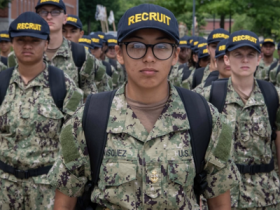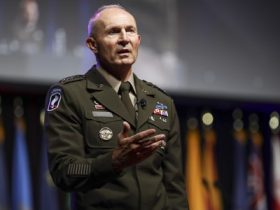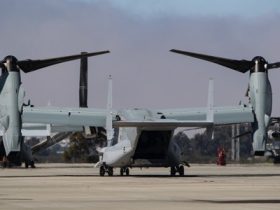Pentagon chief Lloyd Austin visited Ukraine to announce a new $400 million U.S. weapons pledge Monday. Austin’s trip, his fourth as defense secretary, comes as the rate of daily Russian drone attacks have reportedly risen nearly threefold over the past two months heading into winter.
At least 116 Russian drones targeted locations across the invaded country, including 10 sent to the capital city from several directions and in different waves over about five hours, military official Serhiy Popko said on Telegram.
Panning out: Russian drone attacks in Ukraine “have increased from 350 strikes in July, to 750 in August, to 1,500 in September,” the New York Times reports, citing two Western officials.
Austin met with President Volodymir Zelenskyy to discuss “Ukraine’s air defense capabilities, preparations for the winter period, and the expansion of long-range weapon use against Russian military targets,” Zelenskyy wrote on social media, thanking the White House as well as “both parties in the U.S. Congress, and the American people for all their support.”
Developing: Estonia is looking to acquire weapons and gear to hit an invading force before it reaches the country’s borders, Defense One’s Patrick Tucker reported this weekend. Officials in Tallinn are also considering boosting their spending on anti-air defenses, perhaps short-range man-portable missiles or longer-range interceptors, the head of Estonia’s defense procurement office said. Details, here.
NATO chief Mark Rutte called South Korean President Yoon Suk Yeol on Monday, both officials confirmed afterward. Driving that conversation: Recent allegations North Korea has sent around 1,500 special forces to Russia for use against Ukraine. Rutte: “North Korea sending troops to fight alongside Russia in Ukraine would mark a significant escalation,” the new alliance chief said on social media Monday.
Yoon: “Russia’s invasion of Ukraine and the reckless military alignment between Russia and North Korea once again confirm that the security of the Indo-Pacific region and the Atlantic region are inextricably linked,” the South Korean leader said in a statement. “This undermines the rules-based international order, threatening peace on the Korean Peninsula and globally, and the government will never stand by and let this happen,” he wrote.
Expert reax: “Manpower is likely the single most important factor in the war,” said Rob Lee of the Foreign Policy Research Institute. “If Ukraine’s mobilization numbers continue to decrease and Russia can sustain its monthly recruitment efforts (including possibly with North Korean soldiers), the situation will continue to deteriorate unless Ukraine’s foreign partners can provide greater support,” he warned on social media Saturday.
Additional reading:
Welcome to this Monday edition of The D Brief, brought to you by Ben Watson with Bradley Peniston. Share your newsletter tips, reading recommendations, or feedback here. And if you’re not already subscribed, you can do that here. On this day in 1944, Japanese pilots carried out what some historians believe to be the first-ever deliberate kamikaze attack when an Aichi D3A struck Aussie cruiser HMAS Australia’s foremast in the Battle of Leyte Gulf, killing 30 people, including the ship’s captain, and wounding 64 others.
Update: Navy pronounces missing EA-18G Growler aviators dead. The electronic warfare jet crashed east of Mount Rainier on Tuesday. Their names are being withheld pending notification of next of kin, AP reports.
GAO: The U.S. Army has a fleet of 70 boats, but less than 40% are ready to go. That’s a steep drop from 75% just four years ago for a fleet spread across Virginia, Hawaii, and Japan, according to a congressionally-mandated watchdog report published last week.
Why bring it up? “Demand for Army watercraft is increasing, especially in the Indo-Pacific,” the Government Accountability Office writes in its report. Some of those boats were also called upon to help in the construction a pier for humanitarian aid to Gaza this past spring; in the process, four were beached after becoming unmoored, scattering the pier during bad weather in late May.
A Navajo Code Talker from World War II has died at 107. John Kinsel Sr., was among the hundreds of Navajos recruited by the Marines to serve as Code Talkers during the war, “transmitting messages based on their then-unwritten native language,” AP reports. “They confounded Japanese military cryptologists during World War II and participated in all assaults the Marines led in the Pacific from 1942 to 1945, including at Guadalcanal, Tarawa, Peleliu and Iwo Jima.”
Just two Code Talkers remain alive: Thomas H. Begay and Peter MacDonald, a former Navajo Chairman.
U.S. and U.S.-backed Syrian forces at the Conoco Base in Deir ez Zour were attacked Saturday by rockets that reportedly triggered counter-battery fire. The Washington Institute has been keeping track of alleged attacks on U.S. forces across both Iraq and Syria, as well as attacks directed at Israel, over the past 12 months in a chronological table, here.
See also:
Commentary: How to do autonomous flight right. “It seems like military-grade autonomous flight technologies are being announced every other week,” writes Matt George, CEO of Merlin, a flight-autonomy engineering firm. “But that breakneck pace should actually cause concern. Simply put, too many of these touted solutions prioritize announcing demos in a sandbox over nailing the true fundamentals. If we don’t build and scale autonomous flight the correct way, American warfighters and our national security could pay a severe price.” Read that, here.
Related reading:
And lastly: Trump’s radical view would test the military, Defense One’s Bradley Peniston writes in a commentary published Friday. How might Donald Trump use the U.S. military if he returned to the Oval Office? Against his political enemies, as the GOP president said recently in a Fox interview.
Former members of Trump’s own national-security team have issued their own warnings about their former boss, documenting his interest in shooting protestors and calling him “the most dangerous person to this country.”
Mark Esper: “He’s spoken about this before. If you recall a year ago or so, he spoke about a second Trump term being about retribution. So, yes, I think we should take those words seriously,” the former defense secretary told CNN last week.
Members of the military should think carefully about how they would react to such orders, observers said. “If he wins [the] election, the military will be asked to do things that violate their oath of office—the oath they swear to the Constitution. And what are they going to do? They need to think about it ahead of time,” said political scientist Matthew MacWilliams.
Echoing other scholars of authoritarianism, National Defense University Gregory Foster has suggested troops and commanders contemplate their moral, ethical, and legal duties now.
Read the full article here








Leave a Reply